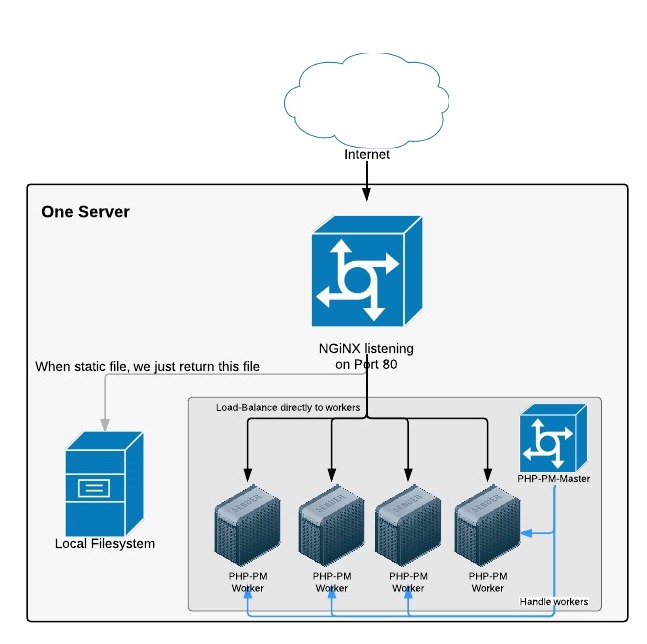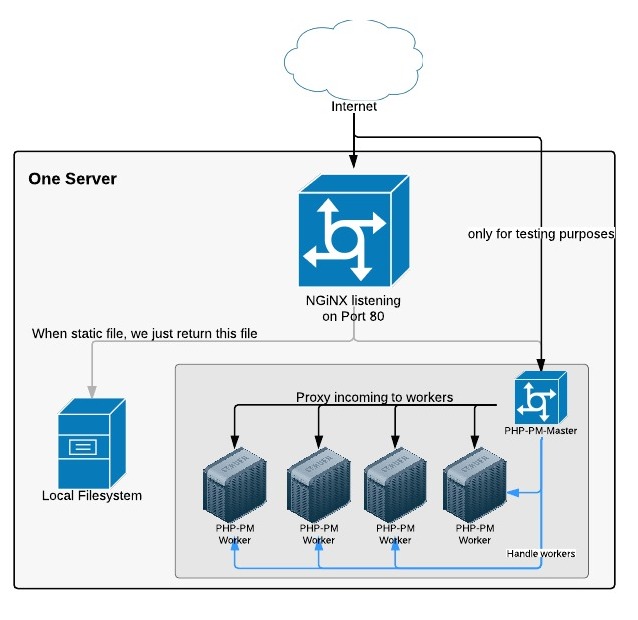PPM - PHP Process Manager
PHP-PM is a process manager, supercharger and load balancer for PHP applications.
It's based on ReactPHP and works best with applications that use request-response frameworks like Symfony's HTTPKernel. The approach of this is to kill the expensive bootstrap of PHP (declaring symbols, loading/parsing files) and the bootstrap of feature-rich frameworks. See Performance section for a quick hint. PHP-PM basically spawns several PHP instances as worker bootstraping your application (eg. the whole Symfony Kernel) and hold it in the memory to be prepared for every incoming request: This is why PHP-PM makes your application so fast.
More information can be found in the article: Bring High Performance Into Your PHP App (with ReactPHP)
Features
- Performance boost up to 15x (compared to PHP-FPM, Symfony applications).
- Integrated load balancer.
- Hot-Code reload (when PHP files changes).
- Static file serving for easy development procedures.
- Support for HttpKernel (Symfony/Laravel), Drupal (experimental), Zend (experimental).
Why using PPM as development server instead of vagrant, nginx or apache?
- No hassle with file permissions (www-data vs local user ids).
- No painful slow virtual-box file sync.
- Faster response times of your PHP app.
- No fighting with vagrant / virtual machine settings.
- Checkout a new project, run
ppm start- done. (if configured withppm config) - No hassle with domain names (/etc/hosts), just use different ports for your app without root access.
Installation
To get PHP-PM you need beside the php binary also php-cgi, which comes often with php. If not availabe try to install it:
Debian/Ubuntu (https://www.digitalocean.com/community/tutorials/how-to-upgrade-to-php-7-on-ubuntu-14-04)
apt-get install php7.0-cgi
By default cgi bin is in /usr/lib/cgi-bin/php, so you need to run:
sudo ln -s /usr/lib/cgi-bin/php /usr/bin/php7.0-cgi
Mac OS X - Homebrew (https://github.com/Homebrew/homebrew-php)
brew install php70
Mac OS X - Macports
port install php70-cgi
By default, PPM looks for a binary named php-cgi. If your PHP installation uses
a different binary name, you can specify the full path to that binary with the php-cgi
configuration option (for example: ppm config --php-cgi=/opt/local/bin/php-cgi70).
Global
$ git clone git@github.com:php-pm/php-pm.git
$ cd php-pm
$ composer install
$ ln -s `pwd`/bin/ppm /usr/local/bin/ppm
$ ppm --helpPer project
# change minimum-stability to dev in your composer.json (until we have a version tagged): "minimum-stability": "dev"
composer require php-pm/php-pm:dev-master
composer require php-pm/httpkernel-adapter:dev-master #if you have httpkernel (laravel, symfony)
./vendor/bin/ppm config --bootstrap=symfony #places a ppm.json in your directory
./vendor/bin/ppm start #reads ppm.json and starts the server like you wantOnce configured (composer and ppm.json) you can start your app on your development machine or server instantly:
composer install
./vendor/bin/ppm startWhen debug is enabled, PHP-PM detects file changes and restarts its worker automatically.
Performance
To get the maximum performance you should usually use --app-env=prod with disabled
debug --debug=0. Also make sure xdebug is disabled. Try with different amount of workers.
Usually a 10% over your cpu core count is good. Example: If you have 8 real cores (excl. hyper-threading) use --workers=9.
If your applications supports it, try enabled concurrent requests per worker: --concurrent-requests=1.
To get even more performance (for static file serving or for rather fast applications) try a different event loop (see https://github.com/reactphp/event-loop).
Debugging
If you get strange issues in your application and you have no idea where they are coming from try
using only one worker --workers=1 and enable -v or -vv.
When debugging you should use xdebug as you're used to. If you set a break point and hold the application, then only one worker is stopped until you release the break point. All other workers are fully functional.
In all workers the STDOUT is redirected to the connected client. So take care, var_dump, echo are not displayed on the console.
STDERR is not redirected to the client, but to the console. So, for very simple debugging you could use error_log('hi') and you'll see it on the console.
Per default exceptions and errors are only displayed on the console, prettified with Symfony/Debug component.
Adapter
HttpKernel for Symfony/Laravel - https://github.com/php-pm/php-pm-httpkernel
Drupal - https://github.com/php-pm/php-pm-drupal
Zend - https://github.com/php-pm/php-pm-zend
Command
Start
cd ~/my/path/to/symfony/
ppm start
ppm start ~/my/path/to/symfony/ --bootstrap=Symfony --bridge=HttpKernel
cd ~/my/path/to/symfony/
./vendor/bin/ppm startSymfony
cd my-project
composer require php-pm/httpkernel-adapter:dev-master
$ ./bin/ppm start --bootstrap=symfonyLaravel
cd my-project
composer require php-pm/httpkernel-adapter:dev-master
$ ./vendor/bin/ppm start --bootstrap=laravelDrupal
cd my-project
composer require php-pm/httpkernel-adapter:dev-master
$ ./bin/ppm start --bootstrap=drupalZend
cd my-project
composer require php-pm/zend-adapter:dev-master
$ ./bin/ppm start --bridge=Zf2 --bootstrap=Zf2Each worker starts its own HTTP Server which listens on port 5501, 5502, 5503 etc. Range is 5501 -> 5500+<workersCount>.
You can integrate those workers directly in a load balancer like NGINX or use http://127.0.0.1:8080 directly.
Performance
6x3,2 GHz Intel, 16GB RAM. 20 concurrent, 1000 total request: ab -c 20 -n 1000 http://127.0.0.1:8080/
PHP 7, StreamSelectLoop
/usr/local/bin/php7 ./bin/ppm start ~/www/symfony--bridge=httpKernel --app-env=prod --logging=0 --debug=0 --workers=8
Static file: 2371.93 requests/s
Dynamic CMS application: 1685.80 request/s (http://jarves.io)
PHP 5.6.18, StreamSelectLoop
/usr/local/bin/php5 ./bin/ppm start ~/www/symfony --bridge=httpKernel --app-env=prod --logging=0 --debug=0 --workers=8
Static file: 1818.52 requests/s
Dynamic CMS application: 1270.30 request/s (http://jarves.io)
Issues
- Memory leaks, memory leaks and memory leaks. You will find also leaks in your application. :)
- Does not work with ExtEventLoop. (So don't install
php70-event) - Drupal is very experimental and not fully working. Try using https://github.com/php-pm/php-pm-drupal.
- Symfony's and Laravel's profiler aren't working yet perfectly since it's still needed to reset some stuff after each request.
- Streamed responses are not streamed yet
- File upload is experimental
- No windows support due to signal handling
- Doesn't fully implement HTTP/1.1, but reactphp/http is working on it.
Please help us to fix those issues by creating pull requests. :)
Setup 1. Use external Load-Balancer
Example config for NGiNX:
upstream backend {
server 127.0.0.1:5501;
server 127.0.0.1:5502;
server 127.0.0.1:5503;
server 127.0.0.1:5504;
server 127.0.0.1:5505;
server 127.0.0.1:5506;
}
server {
root /path/to/symfony/web/;
server_name servername.com;
location / {
try_files $uri @backend;
}
location @backend {
proxy_pass http://backend;
}
}Setup 2. Use internal Load-Balancer
This setup is slower as we can't load balance incoming connections as fast as NGiNX it does, but it's perfect for testing purposes.



